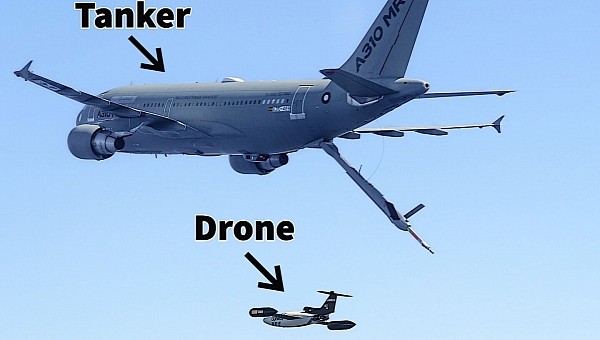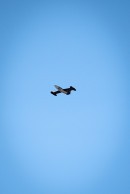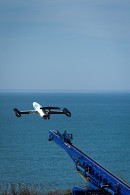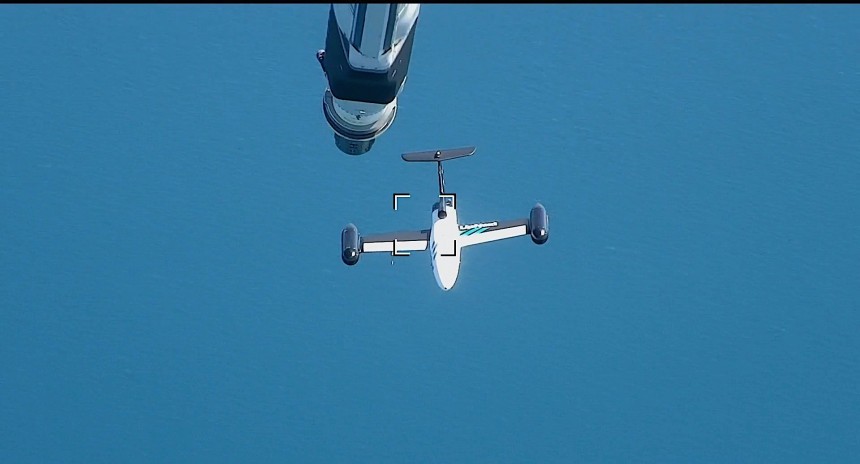In the military world drones are already a constant and reliable presence. Having arrived not so many years ago, they now come in a variety of shapes and sizes, and are used for multiple purposes both on battlefields and away from them. But capable as they may seem, drones have a lot more potential to grow.
Efforts currently being made by the defense industry focus on joint operations of crewed aircraft and drones. For that to happen, autonomous abilities are key, so many companies playing in this industry are currently focusing on that.
The Europeans from Airbus are part of that group, and this week they announced a breakthrough concerning drones’ ability to fly and approach an aerial tanker on their own for refueling operations.
The achievement took place last week over the Gulf of Cadiz off the coast of Portugal and involved one Airbus A310 MRTT tanker and several DT-25 target drones. If this type of drone sounds familiar it's because Airbus has been playing with them for a while, trying to integrate them into joint operations with crewed aircraft.
This time, the drones had to get into an in-flight refueling position on their own, using guidance provided by the A310’s specialized onboard systems. Those systems are called Auto’Mate, and they’ve been put together by Airbus’ subsidiary UpNext.
It’s not exactly public knowledge what the systems are all about, but Airbus says it allowed the four drones used for the test to be “sequentially controlled and commanded” by an AI with absolutely no intervention from humans.
The AI guided the drones after it received control over them from the ground station, and was able to bring the DT-25s into refueling position. That means they got as close as 150 feet (45 meters) from the A310, which is about where you’d want them for refueling operations.
Airbus does not say if anything else was achieved apart from the drones autonomously getting into position (like, say actual refueling). We are informed though that the six-hour flight test went without a hitch and “paves the way for developing autonomous and unmanned air-to-air refueling technologies.”
Airbus has been at it trying to find ways to allow joint aerial operations between human-controlled drones and autonomous ones for several years now, and it will continue to press the accelerator pedal. Later this year, further tests of the Auto’Mate are planned, and they will focus on “exploring the use of navigation sensors based on artificial intelligence and enhanced algorithms for autonomous formation flight.”
A repeat of this month’s test, with two simulated drones flying in close proximity to an A310, will also be conducted, but this time as a means to prove collision-avoidance algorithms work as intended.
Aside from the obvious military advantages of having drones fly formation with crewed aircraft, Airbus says such systems could also help reduce crew fatigue, but also diminish the cost of training people to do something autonomous systems could do on their own.
For now, there is no timeframe as to when we’re to see the results of such collaboration between man and machine in the real world.
The Europeans from Airbus are part of that group, and this week they announced a breakthrough concerning drones’ ability to fly and approach an aerial tanker on their own for refueling operations.
The achievement took place last week over the Gulf of Cadiz off the coast of Portugal and involved one Airbus A310 MRTT tanker and several DT-25 target drones. If this type of drone sounds familiar it's because Airbus has been playing with them for a while, trying to integrate them into joint operations with crewed aircraft.
This time, the drones had to get into an in-flight refueling position on their own, using guidance provided by the A310’s specialized onboard systems. Those systems are called Auto’Mate, and they’ve been put together by Airbus’ subsidiary UpNext.
The AI guided the drones after it received control over them from the ground station, and was able to bring the DT-25s into refueling position. That means they got as close as 150 feet (45 meters) from the A310, which is about where you’d want them for refueling operations.
Airbus does not say if anything else was achieved apart from the drones autonomously getting into position (like, say actual refueling). We are informed though that the six-hour flight test went without a hitch and “paves the way for developing autonomous and unmanned air-to-air refueling technologies.”
Airbus has been at it trying to find ways to allow joint aerial operations between human-controlled drones and autonomous ones for several years now, and it will continue to press the accelerator pedal. Later this year, further tests of the Auto’Mate are planned, and they will focus on “exploring the use of navigation sensors based on artificial intelligence and enhanced algorithms for autonomous formation flight.”
A repeat of this month’s test, with two simulated drones flying in close proximity to an A310, will also be conducted, but this time as a means to prove collision-avoidance algorithms work as intended.
Aside from the obvious military advantages of having drones fly formation with crewed aircraft, Airbus says such systems could also help reduce crew fatigue, but also diminish the cost of training people to do something autonomous systems could do on their own.
For now, there is no timeframe as to when we’re to see the results of such collaboration between man and machine in the real world.








